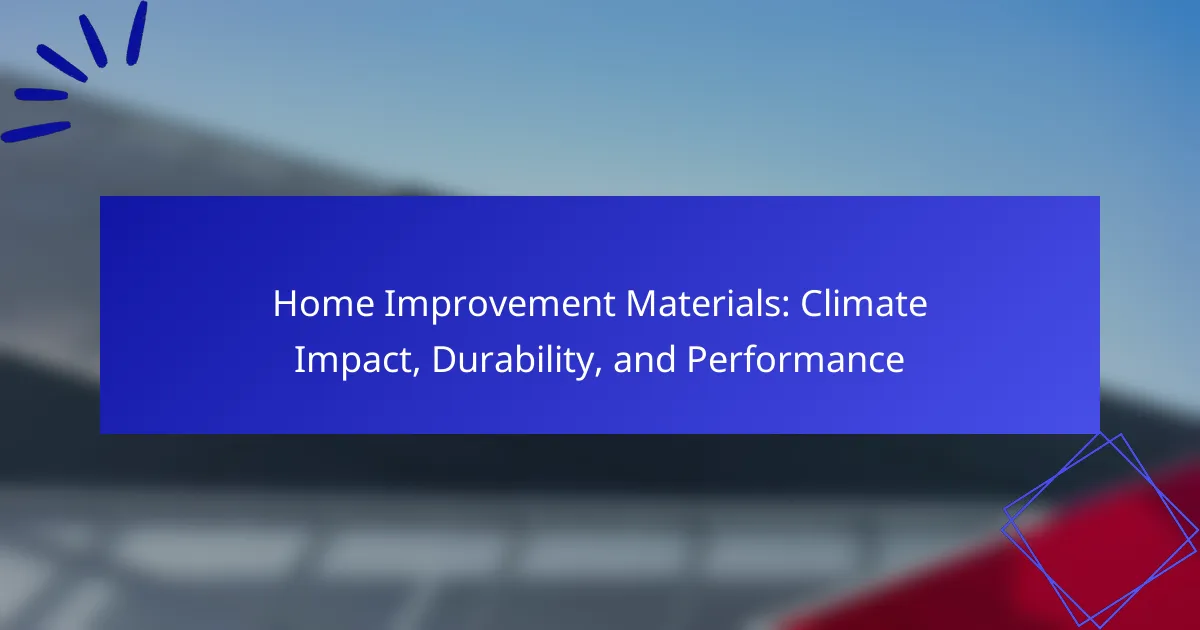When selecting home improvement materials, it’s crucial to consider their climate impact, durability, and performance. Materials like recycled steel and eco-friendly insulation not only enhance energy efficiency but also withstand environmental stressors. By understanding performance metrics such as thermal ratings and moisture resistance, homeowners can make informed choices that improve longevity and reduce maintenance costs.

What are the best home improvement materials for climate resilience?
The best home improvement materials for climate resilience are those that withstand environmental stressors while minimizing ecological impact. Key options include recycled steel, insulated concrete forms, and eco-friendly insulation, each offering unique benefits in durability and energy efficiency.
Recycled steel for framing
Recycled steel is a strong, sustainable choice for home framing, as it is both durable and resistant to pests and rot. Using recycled materials reduces waste and the demand for new steel production, which is energy-intensive.
When considering recycled steel, ensure it meets local building codes and standards. This material can be more expensive upfront compared to traditional wood framing, but its longevity and low maintenance can lead to cost savings over time.
Insulated concrete forms for energy efficiency
Insulated concrete forms (ICFs) provide excellent thermal insulation, making homes more energy-efficient and comfortable. These forms consist of expanded polystyrene (EPS) or similar materials that create a strong, insulated wall structure.
ICFs can help reduce heating and cooling costs significantly, often by 20-50% compared to traditional framing. They also offer superior resistance to severe weather, making them ideal for areas prone to storms or extreme temperatures.
Eco-friendly insulation options
Eco-friendly insulation materials, such as cellulose, sheep’s wool, and spray foam, provide effective thermal performance while minimizing environmental impact. Cellulose, made from recycled paper, is particularly notable for its low carbon footprint and excellent air sealing properties.
When selecting insulation, consider factors like R-value, moisture resistance, and local availability. Using eco-friendly options can lead to healthier indoor air quality and lower energy bills, making them a smart choice for sustainable home improvement.

How do different materials impact durability?
Different materials significantly affect the durability of home improvement projects. Choosing the right material can enhance longevity, reduce maintenance costs, and improve overall performance in various climates.
Wood vs. composite decking
Wood decking typically offers a classic aesthetic but requires regular maintenance to prevent rot and insect damage. Composite decking, made from a blend of wood fibers and plastic, is more resistant to moisture and UV damage, making it a durable alternative with less upkeep.
When selecting between the two, consider the climate. In humid areas, composite may outperform wood due to its resistance to warping and decay. However, wood can be more cost-effective upfront, while composite often comes with a longer warranty, reflecting its durability.
Metal roofing longevity
Metal roofing is known for its exceptional durability, often lasting 40-70 years depending on the material type, such as steel or aluminum. It withstands extreme weather conditions, including heavy rain, snow, and high winds, making it a reliable choice for various climates.
Investing in metal roofing can reduce long-term costs associated with repairs and replacements. Additionally, many metal roofs are designed to reflect heat, which can lower energy bills in warmer regions. Ensure proper installation to maximize its lifespan and performance.
Concrete vs. asphalt for driveways
Concrete driveways generally last longer than asphalt, with a lifespan of 30 years or more compared to asphalt’s 15-20 years. Concrete is more resistant to cracking and can handle heavier loads, making it suitable for high-traffic areas.
However, asphalt is typically less expensive and easier to repair. In colder climates, asphalt can be advantageous as it remains flexible and less prone to cracking in freeze-thaw cycles. Consider local weather conditions and budget when choosing between these two materials for driveways.

What are the performance metrics for home improvement materials?
The performance metrics for home improvement materials include thermal performance ratings, moisture resistance levels, and fire ratings. These metrics help assess how well materials will perform under various environmental conditions, impacting durability and safety.
Thermal performance ratings
Thermal performance ratings indicate how well a material insulates against heat transfer. Common metrics include R-value, which measures resistance to heat flow, and U-value, which measures heat transfer through a material. Higher R-values signify better insulation, making materials with R-values above 30 suitable for colder climates.
When selecting insulation materials, consider the climate of your area. For instance, in regions with harsh winters, materials like spray foam or fiberglass batts with high R-values are preferable. Always check for compliance with local building codes regarding insulation standards.
Moisture resistance levels
Moisture resistance levels determine how well materials can withstand water exposure without degrading. This is crucial for preventing mold growth and structural damage. Materials are often rated based on their permeability, with lower permeability indicating better moisture resistance.
For areas prone to high humidity or water exposure, such as bathrooms or basements, opt for materials like treated wood or moisture-resistant drywall. Always ensure proper installation to maximize moisture resistance and consult local regulations regarding moisture control in construction.
Fire ratings of building materials
Fire ratings assess how materials react to fire, indicating their ability to withstand flames and heat. Common classifications include Class A, B, and C, with Class A materials offering the highest fire resistance. These ratings are essential for ensuring safety and compliance with fire codes.
When choosing materials, consider their fire ratings, especially in high-risk areas or multi-family dwellings. For example, using non-combustible materials like concrete or steel can enhance safety. Always verify that materials meet local fire safety regulations and standards.

What criteria should be considered when selecting materials?
When selecting materials for home improvement, consider their environmental impact, durability, and overall performance. These criteria will help ensure that your choices are sustainable, cost-effective, and suitable for your specific needs.
Environmental impact assessments
Environmental impact assessments evaluate how materials affect the ecosystem throughout their lifecycle. This includes extraction, manufacturing, transportation, use, and disposal. Look for materials with certifications like LEED or Energy Star, which indicate lower environmental footprints.
Consider the sourcing of materials as well. Locally sourced materials often have a reduced carbon footprint due to shorter transportation distances. Additionally, materials that are recyclable or biodegradable can significantly lessen long-term environmental impacts.
Cost vs. long-term savings
When weighing cost against long-term savings, it’s essential to consider both initial expenses and future maintenance costs. While cheaper materials may save money upfront, they often require more frequent replacements or repairs, leading to higher overall costs over time.
For example, investing in high-quality insulation may have a higher initial cost but can lead to significant savings on energy bills. A good rule of thumb is to calculate the total cost of ownership over a period of years to determine the best value.

How do local climates affect material choice?
Local climates significantly influence the selection of home improvement materials, as different weather conditions demand specific properties for durability and performance. Understanding these climate-related factors helps homeowners make informed decisions that enhance the longevity and effectiveness of their building projects.
Materials for humid climates
In humid climates, materials must resist moisture and prevent mold growth. Opt for treated wood, fiber cement siding, and vinyl, as these materials can withstand high humidity levels without deteriorating. Additionally, consider using breathable membranes that allow moisture to escape while keeping the interior dry.
When selecting roofing materials, metal and asphalt shingles are preferable due to their resistance to mold and algae. Regular maintenance, such as cleaning gutters and inspecting for leaks, is essential to prolong the lifespan of these materials in humid environments.
Cold climate insulation needs
Cold climates require effective insulation to maintain energy efficiency and comfort. Materials like fiberglass, foam board, and spray foam are excellent choices, as they provide high R-values, which measure thermal resistance. Proper installation is crucial to avoid air leaks that can undermine insulation performance.
In addition to insulation, consider using triple-glazed windows and insulated doors to minimize heat loss. Investing in these materials can lead to significant energy savings during the colder months, making your home more comfortable and reducing heating costs.

What are the emerging trends in sustainable materials?
Emerging trends in sustainable materials focus on reducing environmental impact while enhancing durability and performance. Innovations include the use of recycled content, bio-based materials, and energy-efficient manufacturing processes that align with eco-friendly building practices.
Recycled Materials
Recycled materials are gaining traction in home improvement due to their lower environmental footprint. Products made from recycled plastics, metals, and glass not only divert waste from landfills but also reduce the need for virgin resources. For example, recycled concrete can be used in new construction, providing a sustainable alternative to traditional aggregates.
Bio-based Materials
Bio-based materials, derived from renewable resources, are becoming increasingly popular in sustainable construction. Materials such as bamboo, cork, and hemp offer excellent durability and insulation properties while being biodegradable. These options are particularly appealing for homeowners looking to minimize their ecological impact.
Energy-efficient Manufacturing
Energy-efficient manufacturing processes are crucial for reducing the carbon footprint of building materials. Techniques such as low-energy kiln drying and the use of renewable energy sources in production can significantly lower emissions. Homeowners should look for certifications like Energy Star or LEED to identify products that meet these standards.
Local Sourcing
Local sourcing of materials not only supports regional economies but also minimizes transportation emissions. By choosing materials produced within a certain radius, homeowners can significantly reduce the environmental impact associated with shipping. This practice often leads to fresher, more sustainable options that are better suited to local climates.





